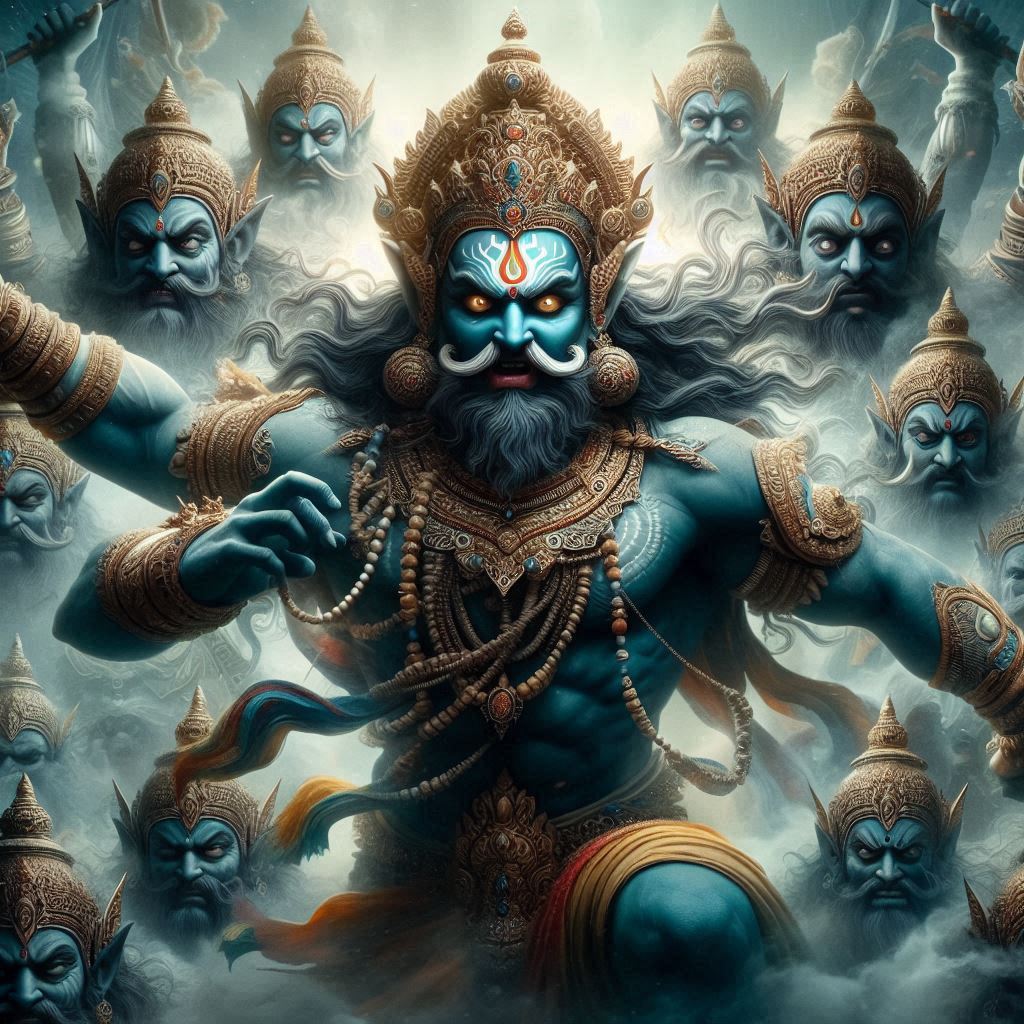
RAVANA: THE RISE AND FALL OF THE TEN-HEADED KING
- Birth and Prophecy
Ravana was born to the sage Vishrava and the demoness Kaikasi. (Valmiki Ramayana, Balakanda) Even before his birth, sages had prophesied that this son would be a great scholar and immensely powerful, but if conquered by arrogance and cruelty, he would become a calamity for the world. Ominous signs appeared at his birth—dark clouds gathered in the sky, a fierce storm began, and lightning flashed continuously, as if foretelling his turbulent future.
- Education and Divine Boons
From a young age, Ravana was exceptionally intelligent and strong. He learned the Vedas, Upanishads, and scriptures from his father. Under the guidance of his guru, Shukracharya, he mastered tantra, warfare, and mystical arts (Ramayana, Uttara Kanda). Due to his intense devotion to Lord Shiva, he traveled to Mount Kailash and attempted to lift the mountain to prove his strength. However, Lord Shiva pressed the mountain down with just a finger, causing Ravana immense pain. In repentance, Ravana composed the “Shiva Tandava Stotram,” which pleased Shiva, who then gifted him the Chandrahas sword (Shiva Purana).
- Reign Over Lanka
Ravana’s father had given the golden kingdom of Lanka to his stepbrother, Kubera. But the ambitious and mighty Ravana attacked Kubera and seized control of Lanka, becoming the supreme king of the demons (Ramayana, Aranya Kanda).
- The Symbolism of Ravana’s Ten Heads
(According to the Shiva Purana) Ravana was granted the boon of ten heads (Dashamukha), but they were not physically present. His ten heads symbolized the following knowledge:
✔ The four Vedas
✔ The six Shastras (Sankhya, Yoga, Nyaya, Vaisheshika, Mimamsa, Vedanta)
However, some legends suggest he indeed had ten physical heads, representing his immense intellect and ego.
- Ravana’s Intense Penance and Boon from Brahma
Desiring immortality, Ravana performed severe penance. He worshipped Lord Brahma for thousands of years, but Brahma remained unmoved. Finally, Ravana cut off his nine heads one after another and offered them into the fire. As he prepared to sever his tenth head, Brahma appeared and granted him a boon. Ravana asked for immortality, but Brahma refused. Instead, Ravana sought invincibility against gods, demons, gandharvas, yakshas, danavas, nagas, and animals—but he overlooked humans. Brahma granted this boon, making him invulnerable to all these beings.
- Family and Wives
Ravana’s chief wife, Mandodari, was highly intelligent and righteous. She constantly advised him against wrongdoing. His son Meghnad (Indrajit) was a mighty warrior who even defeated Indra, the king of gods (Ramayana, Yuddha Kanda). He had another son, Akshayakumara, and a noble brother, Vibhishana, who later sided with Lord Rama.
- Ravana’s Conquests and Boons
Ravana conquered heaven, earth, and the netherworld, subjugating the gods. Blinded by pride, he even challenged Yama, the god of death. But Brahma’s boon made him invincible against gods, demons, and other celestial beings (Ramayana, Uttara Kanda). However, his neglect of humans led to his downfall.
- The Abduction of Sita—A Turning Point
According to the Aranya Kanda of Valmiki Ramayana, to avenge Shurpanakha’s humiliation, Ravana abducted Sita. He sent Maricha in the form of a golden deer to distract Rama and Lakshmana and took Sita to Lanka. Despite Mandodari and Vibhishana’s repeated pleas, Ravana refused to return Sita, leading to the Ram-Ravana war.
- The Great War and Ravana’s End
Rama, Hanuman, and the vanara army attacked Lanka. In the war, Ravana’s mighty warriors were defeated. Finally, Lord Rama used the Brahmastra to destroy the nectar in Ravana’s navel and killed him (Ramayana, Yuddha Kanda). Before dying, Ravana imparted wisdom to Lakshmana, known as “Ravana Neeti,” which included teachings on politics, restraint, and the importance of knowledge.
- Lessons from Ravana’s Life
Ravana was an extremely intelligent, devoted Shiva worshipper, and a great warrior, but his arrogance and unrighteousness led to his destruction. His life teaches a clear lesson—knowledge and power, when tainted by ego, lead to one’s own downfall. In his final words, he told Rama: “As long as dharma is on your side, no one can defeat you.”
- Analysis of Different Scriptural References About Ravana’s Lifespan
Ancient texts provide varying accounts of Ravana’s lifespan. Though the Uttara Kanda of Valmiki Ramayana does not explicitly mention it, it is believed he performed penance for 10,000 years, offering one head every 1,000 years. The Treta Yuga lasted 1,296,000 years, and Ravana lived from the middle until its end, suggesting a lifespan of around 1.2 million years, as some scholars believe.
According to the Rudra Samhita in the Skanda Purana, Ravana ruled for 56.16 million years, but this is measured in “divine years” (1 divine year = 360 human years), making his lifespan billions of years. The same text also mentions, “Ravana the demon lived for 600 years,” which could be symbolic.
The Ravana Samhita, an unauthentic text from the 18th century, states he lived around 40,000 years (10,000 in penance, 28,800 as king), but its reliability is doubtful. The Bhagavata Purana (9.10) mentions Ravana was born in the middle of Treta Yuga and lived until its end.
Considering these references, Valmiki Ramayana’s account is the most credible, suggesting Ravana lived for about 1.2 million years. Other texts’ figures may relate to divine chronology, symbolism, or exaggerations. His long life was due to Brahma’s boon, earned through his severe penance.
- Conclusion
Ravana’s story is not just about a villain but a complex personality. His rise was extraordinary, and his fall was inevitable. His life teaches us the consequences of arrogance, the importance of dharma, and the value of wisdom.
source: this content was created with the assistance of AI and has been adapted and curated by Jignesh Gandhi for this blog.